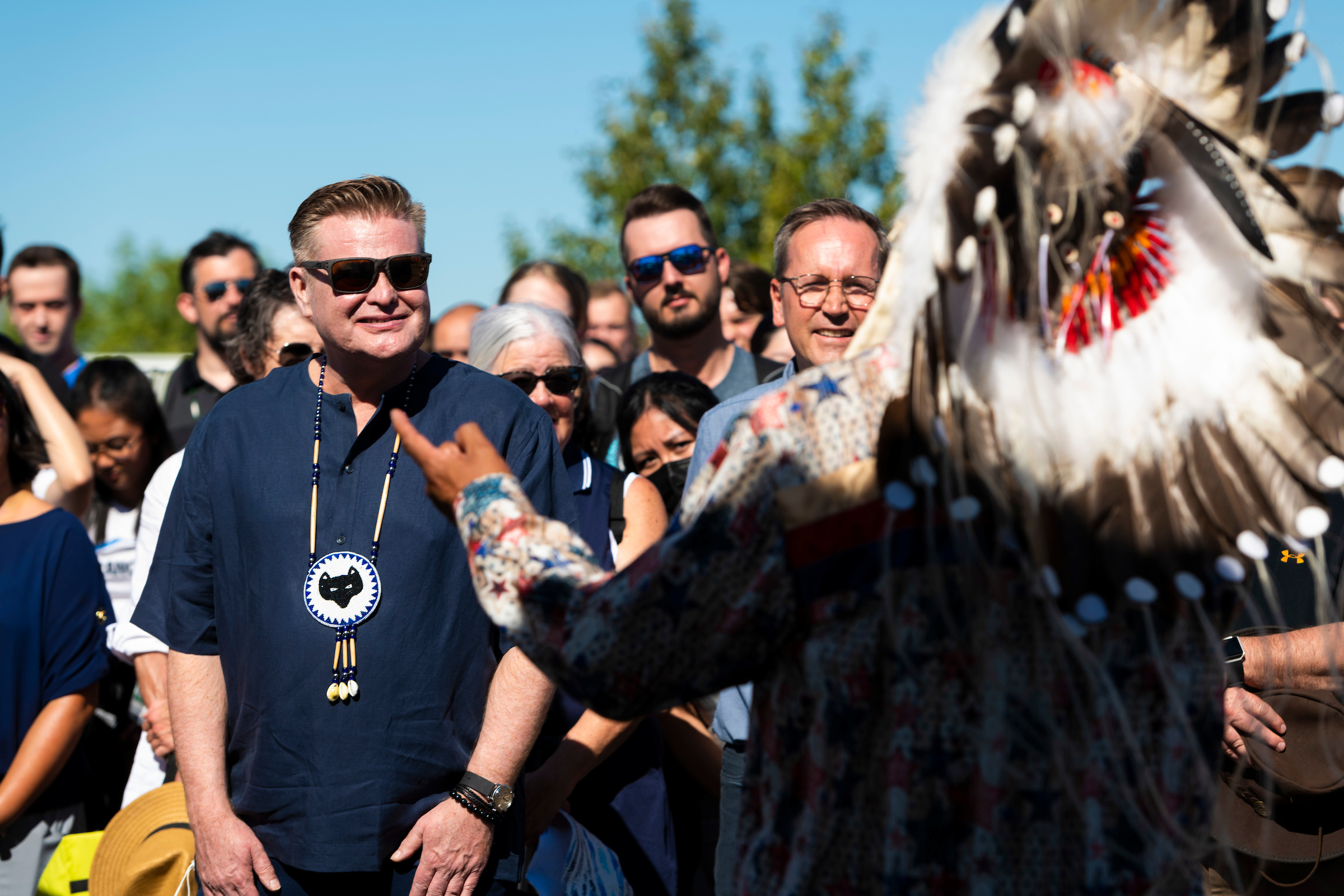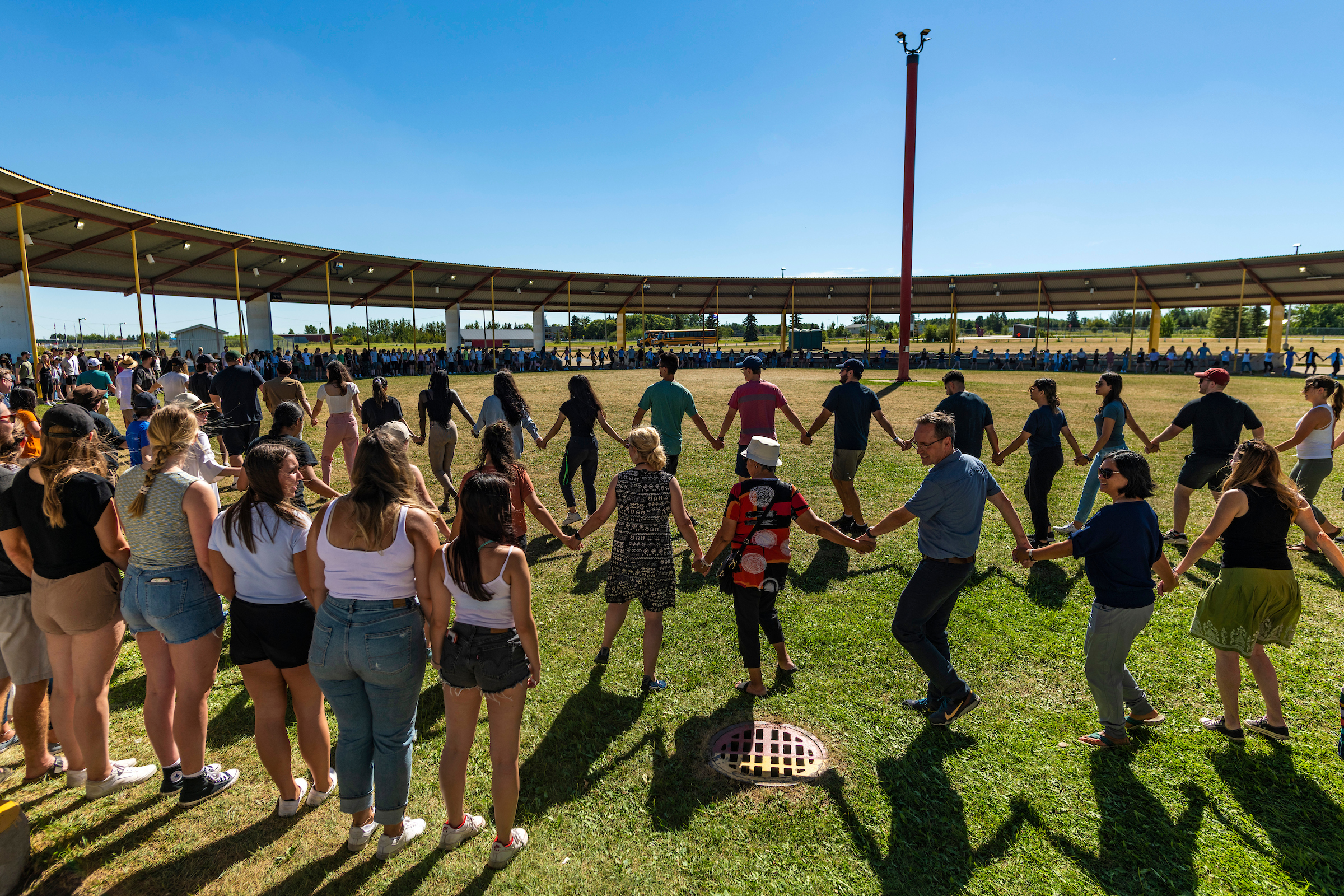Partnering with Indigenous communities for a future of equitable care
Keri Sweetman - 2 November 2022

Wayne Clark (left), executive director of the faculty’s Wâpanacahkos - Indigenous Health Program (IHP).
This fall, the Faculty of Medicine & Dentistry took a new step forward in its commitment to action on Indigenous health. The academic year began for all first-year students in the faculty on ceremonial grounds in Maskwacis, a community of First Nations south of Edmonton.
All students embarking on the faculty’s five undergraduate programs participated in the first-ever, all-day orientation in the Maskwacis community, featuring a ceremonial procession, drum circle and messages from three chiefs, an elder, drummers and local health-care workers. About 300 students were bused to the community, which includes four First Nations ─ Ermineskin Cree Nation, Samson Cree Nation, Louis Bull Tribe and the Montana First Nation.
“This was so important because the students, when they come to university and from different backgrounds, many of them haven’t been on reserve before,” says Wayne Clark, executive director of the faculty’s Wâpanacahkos - Indigenous Health Program (IHP), which organized the orientation day.
“Given that our health-care system is in a state of crisis, we wanted to ensure that our students have a window to see what it is like in a rural Indigenous community.”
Throughout the day, the students heard from three chiefs — Randy Ermineskin, Leonard Standing on the Road and Vernon Saddleback — who outlined the health-care challenges facing their people and emphasized the need for partnerships between Indigenous communities and the medical community. Elder Solomon Bull led the group in prayers. The speakers shared stories about “their ancestors, grandparents and children, their land, and what their way of life means to them,” says Clark. “They wouldn’t get that in a textbook.”
Building empathy and understanding
 For first-year medical student Jeffrey Ilg, the Maskwacis orientation was an eye-opener.
For first-year medical student Jeffrey Ilg, the Maskwacis orientation was an eye-opener.
It was impactful to hear stories directly from First Nations people, he says. “The legacies, both positive and negative, are still here. Getting to hear from them first-hand had far more power to it than reading about it in a book or doing some project.”
Ilg came away with a better understanding of the systemic racism faced by Indigenous people navigating the health system. “I think learning about this is really important to help us provide more empathetic care,” he says.
For many non-Indigenous students like Ilg in the medical program, the first time they learn about Indigenous health happens in the first-year curriculum. Those teachings and the information about social determinants of health “are a bit more sad and negative,” says second-year MD student Abbey Norris, president of the Indigenous Medical and Dental Students Association (IMDSA). Norris is Dene, from the Cold Lake First Nation, on her father’s side.
Like Ilg, Norris attended the Maskwacis orientation and says it was an exciting, important event. It’s even important for Indigenous learners, says Clark, many of whom may have grown up in urban centres and are unfamiliar with the realities of life on reserve. (This year, the first-year class includes eight Indigenous medical students, one in dentistry, three in dental hygiene and one in medical laboratory sciences.)
“It was really important for other students to see that Indigenous culture is really beautiful,” says Norris. “It was great being able to celebrate that with a full day for me as an Indigenous student and to see that the faculty supported us this way.”
Deepening the journey
On Nov. 3, second-year medical student Courtney Hebert will take a group of first- and second-year medical students back to Maskwacis for another full day of activities, including a sweat ceremony. This visit, arranged with the help of Elder-in-Residence Rick Lightning, is part of an Indigenous health elective run by a team of medical students including Hebert, who is Métis from the Region 2 Métis Nation, near St. Paul.
Hebert says it’s particularly important for the students to participate in a sweat ceremony led by pipe carrier and Elder-in-Residence, Rick Lightning. “By promoting this awareness and appreciation for the culture, these medical students will be able to manage their Indigenous patients in the future and really appreciate why people might choose to participate in traditional medicines and ceremonial forms of healing.”
“Some people still don’t understand what privileges they have and what has occurred in the past, and the legacy of colonization, or they just don’t care,” says Clark. “They may have racist attitudes they don’t even realize they have. So it requires a lot more education.”
Clark and the IHP team, along with the Faculty of Medicine & Dentistry, are committed to educating not only students, but faculty, leadership and medical professionals on the importance of reconciliation and the continuing need to address issues of racism and inequality many Indigenous people experience in the health-care system.